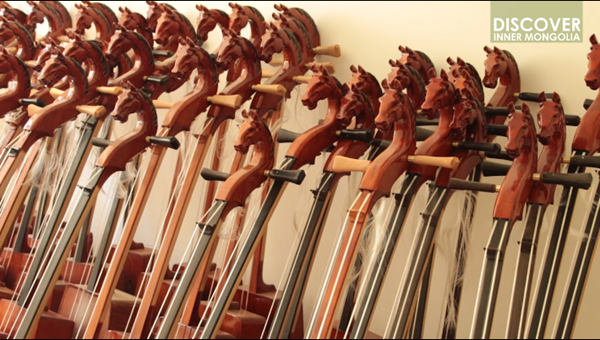For a better timbre: the art of Morin Khuur making

- By Niu Jingjing
 0 Comment(s)
0 Comment(s) Print
Print E-mail China.org.cn, September 28, 2017
E-mail China.org.cn, September 28, 2017
Cha Risu, a Mongolian craftsman, has persisted in making Morin Khuur (also known as the horsehead fiddle) for 17 years. He established a Morin Khuur factory in 2000, eleven years before Morin Khuur crafting was inscribed on China's national intangible cultural heritage list.
|
Morin Khuur (also known as the horsehead fiddle) [Photo / China.org.cn] |
"The Morin Khuur is named after its horse-head headstock. It is the most representative instrument of the Mongol people. Now many people around the world are aware of the instrument, not just Mongolians." said Cha.
However, it's little known how a Mongolian Morin Khuur is made.
The one-meter-long wooden instrument consists of a box-shaped body and long thin neck upon which rests two strings. At first sight people always think that it has only two strings, but actually each of the two strings is composed of hundreds of horse tail hairs. Generally, one is made up of 180 hairs and the other 160 hairs. These days, the strings are made of nylon instead of horse hairs.
"This is the biggest difference from some western string instruments, such as the violin. The Morin Khuur makes a distinct sound - sonorous, undulating and penetrative but not perfectly neat - through the vibration of these 340 strings, which have been inherited from generation to generation. "
The whole process to make a traditional Morin Khuur involve dozens of steps, including the selection of materials, sawmilling, engraving, polish, painting, timbre tuning, etc. In Cha's opinion, the materials are key for a Morin Khuur.
The frame was traditionally covered by horsehide or python skin, but since the 1970s, it has been replaced by painted spruce wood, as the animal skin would easily become damp and warp the wood, which would hurt the tone.
"In the past 17 years, my factory workers and I have been seeking the appropriate materials to make better Morin Khuurs. There is so much to study regarding material selection. For example, due to natural factors the wood varies in hardness and texture, which greatly affects the final quality of the instrument," said Cha.
With the development of the manufacturing industry, many factories prefer to use machines to improve production efficiency. At the same time the increasing demand for the instrument, especially from young players, has led to some fashionable changes in its shape. Despite this trend, Cha still insists that only a handmade Morin Khuur can possibly produce the most beautiful grasslands music.
"Considering that the instrument isn't just an artwork to visually appreciate, what we have pursued is constant improvement of the timbre used to make the Morin Khuur rather than a trendy appearance. The choosing of the timbre depends on the instrument maker's ear. Even though none of us can figure out what kind of timbre is the absolute best, we all have a favorite timbre. That's why I am able to tell my Morin Khuur from the sound," Cha said.
At present, his factory has nine workers and annually they produce around one thousand Morin Khuurs for schools, teachers and performers home and abroad without any sales promotion.
"The Morin Khuurs I've made have been accepted by so many people. This motivates me to improve my skills. Only through the continuous pursuit of an improved Morin Khuur do I believe this heritage will be passed on to more young makers," he said.







Go to Forum >>0 Comment(s)